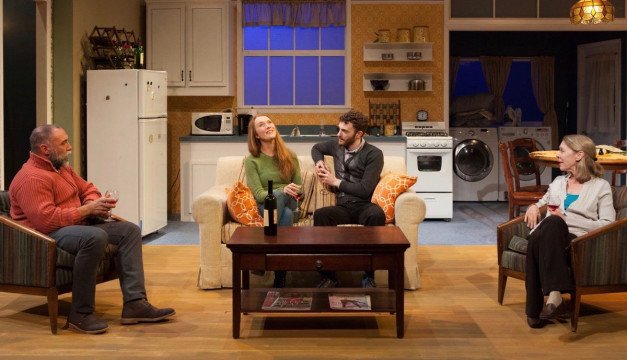REVIEW: In Inis Nua’s Our Few and Evil Days, Family History Goes Awry
What’s most unsettling here happens quietly in the shadows.

Andrew Criss, Amy Frear, Liam Mulshine, and Nancy Boykin in OUR FEW AND EVIL DAYS at Inis Nua. (Photo by Plate 3 Photography)
Don’t be shocked if the first 20 minutes of Our Few and Evil Daysmake you feel as awkward and behind-the-eight-ball as finding yourself at a tense gathering of a family you’ve never met. Who are these people? Why are they here? And what’s the elephant in the room? I felt the same way, and I think it’s the best part of playwright Mark O’Rowe’s evocative and gripping but ultimately uneven play.
The first conversation we hear—between Michael (played by Andrew Criss), a man in late middle-age, and Dennis (Liam Mulshine), who looks to be twenty-something—takes a while to develop, but it turns out that Dennis is the boyfriend of Michael and Margaret (Nancy Boykin), a long-married couple.
I feel safe divulging this information, because it’s revealed early. But trust me – it’s only the tip of the iceberg…which we already suspect, because in a wordless scene that preceded this, we saw Margaret, lovely and fragile, sleeping in a sofa-bed in the waning, inky blue of night.
This world of painful family secrets will slowly but surely come apart. Director Tom Reing skillfully orchestrates the conversational flow of scenes—with enough overlap and pauses to really mark the discomfort—and the interludes where another, lonelier story is told in pictures.
O’Rowe is a master at dropping bits of information that take the audience by surprise. We feel in our bones that the surprise will turn to dread, and (again, I think I can say just this much), it certainly does. But in Act II, as the revelations turn faster and more brutal, they also become increasingly melodramatic and implausible—a pity, since it undercuts the aspects of O’Rowe’s script that feel all too true.
Similarly, the cast (In addition to Boykin, Criss, and Mulshine, they include Amy Frear and Nicholas Roeslar), who are very good at the banter of casual-but-fraught conversations, are less effective as the tone gets darker and the subtext deeper. Boykin, Criss, and Frear don’t convince as a family with decades of history percolating just under the skin. That said, Frear in particular has a compelling, off-center quality that suggests a complex inner life. I look forward to seeing more of her.
Our Few and Evil Daysis an intriguing play that showcases much of what Reing and Inis Nua do very well. The design elements (set by Meghan Jones, lights by Andrew Cowles, and especially sound by Daniel Ison) establish an appropriately moody world. I only wish the climax was as powerful as the build-up. Like so much of life, what’s truly unsettling here happens quietly in the shadows.
Our Few and Evil Days plays through May 13. For more information, visit the Inis Nua website.


